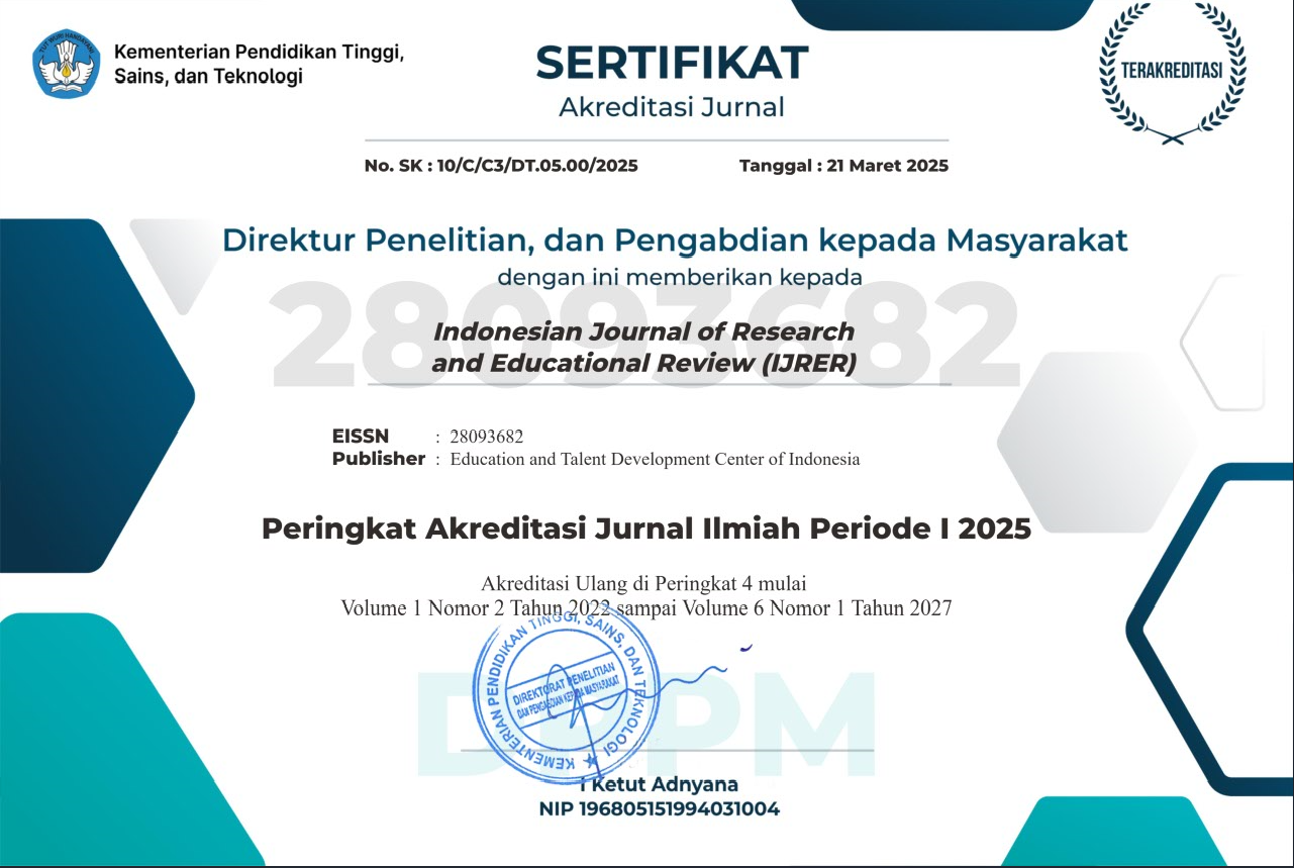Learning Outcomes in Dribbling the Ball Through the STAD Learning Model: Elementary School Students' Football Game Material
DOI:
https://doi.org/10.51574/ijrer.v4i4.3604Keywords:
Classroom Action Research, Dribbling, Football Game, Learning Outcomes , STAD Learning ModelAbstract
This study intends to improve student learning outcomes in dribbling skills in soccer games through the implementation of the Student Teams Achievement Divisions (STAD) cooperative learning model. This study used a classroom action research method with 24 fifth-grade students of Elim Christian Elementary School Makassar as research subjects. Data were collected through learning outcomes tests covering cognitive, affective, and psychomotor aspects. The research instruments were observation sheets, skills tests, and assessment rubrics. Data analysis was carried out descriptively and quantitatively by comparing learning outcomes in pre-cycle, cycle I, and cycle II conditions. The findings of the study are that all learning areas improved significantly. In pre-cycle conditions, the cognitive aspect averaged 58.75, the affective 62.08, and the psychomotor 55.42, with a 16.70% completion rate (4 out of 24 students). The average score increased to 72.92 for cognitive, 75.83 for affective, and 71.25 for psychomotor after STAD was implemented in cycle I, and the completion rate increased to 54.20%–62.50% (13–15 students). In cycle II, learning outcomes were ideal, with an average score of 84.58 for cognitive, 86.25 for emotional, and 83.75 for psychomotor, and a 100% completion rate (24 students). The average score increased 44.55% from pre-cycle to cycle II (58.75 to 84.86). Elim Makassar Christian Elementary School grade V pupils' dribbling skills have improved greatly with STAD cooperative learning. Students' conceptual knowledge, learning attitudes and motivation, and motor skills improved dramatically using this strategy. This study suggests using the STAD model to improve primary school physical education dribbling skills.
References
Abusleme-Allimant, R., Hurtado-Almonacid, J., Reyes-Amigo, T., Yáñez-Sepúlveda, R., Cortés-Roco, G., Arroyo-Jofré, P., & Páez-Herrera, J. (2023). Effects of structured and unstructured physical activity on gross motor skills in preschool students to promote sustainability in the physical education classroom. Sustainability, 15(13), 10167. https://doi.org/10.3390/su151310167
Aidid, W. A., Adawiyah, S. H., Azrai, E., & Aiman, M. A. (2025). The Effect of STAD Type Cooperative Learning Model on Attitude of Responsibility and Learning Outcomes of Football Playing Skills at Secondary School. Journal of Physical Education For Secondary Schools, 5(1), 408-416. https://doi.org/10.17509/jpess.v5i1.82756
Anggreni, N. P., Repiyasa, I. W., & Dewi, K. A. K. (2022). The effect of jigsaw cooperative learning model on learning outcomes of dribbling and passing using the back of the foot football game in class VII students of SMP. Journal Coaching Education Sports, 3(2), 179-188. https://doi.org/10.31599/dc754114
Atradinal, A., & Ockta, Y. (2024). How do the STAD cooperative learning model, conventional methods, and student confidence affect football learning outcomes?. Jurnal Konseling Dan Pendidikan, 12(3), 112-121. https://doi.org/10.29210/1118200
Aziz, A., & Said, T. G. (2025). Penerapan Model Pembelajaran Kooperatif Learning Tipe STAD untuk Meningkatkan Hasil Belajar PKn di Kelas IV SD Inpres Saluttowa. DIKSI: Jurnal Kajian Pendidikan dan Sosial, 6(1), 9-20. https://doi.org/10.53299/diksi.v6i1.1307
Bekris, E., Gissis, I., & Kounalakis, S. (2018). The dribbling agility test as a potential tool for evaluating the dribbling skill in young soccer players. Research in Sports Medicine, 26(4), 425-435. https://doi.org/10.1080/15438627.2018.1492395
Ben Khalifa, W., Zouaoui, M., Zghibi, M., & Azaiez, F. (2020). Effects of verbal interactions between students on skill development, game performance and game involvement in soccer learning. Sustainability, 13(1), 160. https://doi.org/10.3390/su13010160
Destriana, A. (2025). Application Of The Stad Type Cooperative Learning Model To Improve Shooting & Dribbling Skills In Games. COMPETITOR: Jurnal Pendidikan Kepelatihan Olahraga, 17(2), 1331-1341. https://doi.org/10.26858/cjpko.v17i2.117
Dunbar, K., & Yadav, A. (2022). Shifting to student-centered learning: Influences of teaching a summer service learning program. Teaching and Teacher Education, 110, 103578. https://doi.org/10.1016/j.tate.2021.103578
Duncan, M. J., Martins, R., Noon, M., & Eyre, E. L. (2022). Perception of affordances for dribbling in soccer: exploring children as architects of skill development opportunity. Sports, 10(7), 99. https://doi.org/10.3390/sports10070099
Gillies, R., Millis, B., & Davidson, N. (2023). Contemporary global perspectives on cooperative learning. New York: Routledge. Doi, 10, 9781003268192.
Hasbillah, M., Suparman, S., Herman, H., Nurafiati, S., Asri, A., & Angriawan, T. (2024). The Relationship between Balance, Agility, and Eye-Foot Coordination to Dribbling Ability in the Football Game of the Tancung Putra Team of Wajo Regency. JOURNAL RESPECS (Research Physical Education and Sports), 6(3), 309-314. https://www.ejournal.unma.ac.id/index.php/respecs/article/view/10627
Huang, D. (2024). Research on the Relationship Between School Physical Education and Students' Comprehensive Development. International Journal of Educational Teaching and Research, 1(2). https://doi.org/10.70767/ijetr.v1i2.307
Joy, P., Zahavich, J. B., & Kirk, S. F. (2021). Gendered bodies and physical education (PE) participation: Exploring the experiences of adolescent students and PE teachers in Nova Scotia. Journal of Gender Studies, 30(6), 663-675. https://doi.org/10.1080/09589236.2021.1937080
Kirch, A., Schnitzius, M., Spengler, S., Blaschke, S., & Mess, F. (2021). Knowing students' characteristics: Opportunities to adapt physical education teaching. Frontiers in Psychology, 12, 619944.
Legrain, P., Escalié, G., Lafont, L., & Chaliès, S. (2019). Cooperative learning: a relevant instructional model for physical education pre-service teacher training?. Physical Education and Sport Pedagogy, 24(1), 73-86. https://doi.org/10.1080/17408989.2018.1561838
López-Mondéjar, L. M., & Pastor, L. M. T. (2017). Development of socio-emotional skills through cooperative learning in a university environment. Procedia-Social and Behavioral Sciences, 237, 432-437. https://doi.org/10.1016/j.sbspro.2017.02.086
Luwiti, S. R., Mahmud, M., & Panigoro, F. (2023). Analysis of STAD and Jigsaw Cooperative Learning: A recommendation for classroom practices. Jurnal Bahasa, Sastra, dan Budaya, 13(3), 105-141.
Moon, J., & Lee, D. (2025). The theory and practice of modifying soccer: Maximizing learning outcomes in elementary school physical education. Journal of Physical Education and Sport, 25(1), 79-91.
Muhlisin, A., Wijaya, M. A., & Agung, I. G. L. (2021). Pengaruh Model Pembelajaran Kooperatif Tipe Student Teams Achievement Division (STAD) Terhadap Hasil Belajar Passing Sepakbola. Indonesian Journal of Sport and Tourism, 3(2), 43-50. https://doi.org/10.23887/ijst.v3i2.31939
Mursaha, M., Fitrianingsih, J., & Munandar, W. (2022). Upaya Meningkatkan Hasil Belajar Dribbling Melalui Metode Pembelajaran Kooperatif Tipe STAD Dalam Permainan Sepak Bola Siswa Kelas IX B Mts Muhammadiyah Takwa Bontonompo. Kumpulan Artikel Pendidikan Anak Bangsa (Kapasa): Jurnal Pendidikan, Sosial dan Humaniora, 2(1), 15-26.
Nurhayati, N., Tarigan, S., & Lubis, M. (2025). Implementasi dan tantangan Kurikulum Merdeka di SMA: Strategi pengajaran berpusat pada siswa untuk pembelajaran yang lebih fleksibel dan kreatif. Jurnal Pendidikan, 13(1), 69-79.
Pratama, Y. A., Rukmana, A., & Sudirjo, E. (2018). Meningkatkan Gerak Dasar Dribbling dengan Menggunakan Metode Kooperatif Tipe STAD (Student Team Achievment Division) Dalam Permainan Sepak Bola. SpoRTIVE, 3(1), 461-470. https://ejournal.upi.edu/index.php/SpoRTIVE/article/view/13391
Putra, M. U. T., Saman, A., Jud, J., & Rusli, M. (2024). Correlation of Eye and Foot Coordination with Dribbling Ability in a Football Game. Jurnal Pendidikan Jasmani (JPJ), 5(1), 26-35. https://jurnal.stokbinaguna.ac.id/index.php/JPJ/article/view/2268
Salikha, M., Prabowo, E., & Setiawan, I. (2024). Model Pembelajaran Dribbling Sepak Bola Menggunakan Metode Cooperative Tipe Student Teams Achievement Division (STAD) Untuk Siswa SMP. Al-Ihda': Jurnal Pendidikan dan Pemikiran, 19(2), 1551-1564. https://doi.org/10.55558/alihda.v19i2.159
Sejahtra, S., & Manalu, R. B. B. (2024). Improving Student Learning Outcomes Using the STAD Type Cooperative Model. JOURNAL RESPECS (Research Physical Education and Sports), 6(3), 301-307. https://www.ejournal.unma.ac.id/index.php/respecs/article/view/10946
Setyo, A. W. P. (2017). Penerapan Model Pembelajaran Kooperatif Tipe Student Teams Achievement Division (STAD) Terhadap Hasil Belajar Menggiring Sepakbola. Jurnal Pendidikan Olahraga, 215-223.
Siedentop, D., & Van der Mars, H. (2022). Introduction to physical education, fitness, and sport. Human kinetics.
Sioukas, A. (2023). Constructivism and the student-centered entrepreneurship classroom: Learning avenues and challenges for US college students. Industry and Higher Education, 37(4), 473-484. https://doi.org/10.1177/09504222221135311
Slavin, R. E. (2022). Cooperative learning in elementary schools. In Contemporary issues in primary education (pp. 102-111). Routledge.
Slavin, R. E., Hurley, E. A., & Chamberlain, A. (2003). Cooperative learning and achievement: Theory and research. Handbook of psychology: Educational psychology, 7, 177-198.
Slavin, R. E., & Madden, N. A. (2021). Student team learning and success for all: A personal history and overview. In Pioneering perspectives in cooperative learning (pp. 128-145). Routledge.
Suryadi, D., Okilanda, A., Nofrizal, D., Suganda, M. A., Tulyakul, S., Ahmed, M., ... & Bastian, R. H. (2024). How does cooperative learning work with students?: Literature review in physical education. Retos: nuevas tendencias en educación física, deporte y recreación, (55), 527-535. https://dialnet.unirioja.es/servlet/articulo?codigo=9435451
Yang, C., Chen, R., Chen, X., & Lu, K. H. (2021). The efficiency of cooperative learning in physical education on the learning of action skills and learning motivation. Frontiers in psychology, 12, 717528. https://doi.org/10.3389/fpsyg.2021.717528
Yulianti, M., Subagyo, S., Sujarwo, S., Wahyudi, A., Bastian, R. H., Rubiyatno, R., ... & Suryadi, D. (2024). STAD-type cooperative learning model and conventional learning model: A comparative study on the learning outcomes of basic volleyball lower passing techniques. Retos: nuevas tendencias en educación física, deporte y recreación, (55), 346-352. https://dialnet.unirioja.es/servlet/articulo?codigo=9430292

Downloads
Published
How to Cite
Issue
Section
License
Copyright (c) 2025 Andika Tandi Upa’, Sahabuddin Sahabuddin, M. Adam Mappaompo, Suwardi Suwardi, Muh. Adnan Hudain

This work is licensed under a Creative Commons Attribution-ShareAlike 4.0 International License.









1.png)













